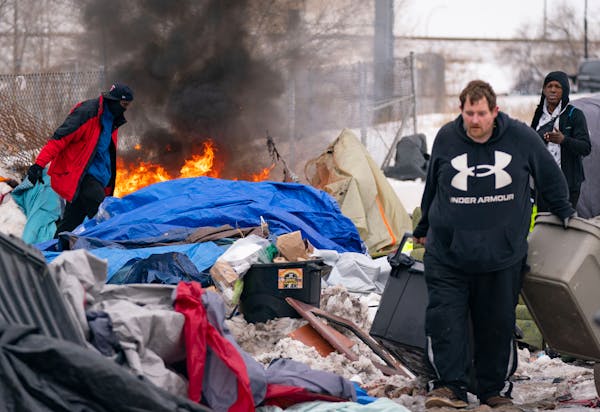To qualify for federal funding, an army of Hennepin County street outreach workers bundled up in the early morning hours this week to count as many people experiencing homelessness as they could find. In addition to emergency shelters, the census takers planned to track people down in food shelves, public libraries and gas station rest areas.
A team arrived Thursday at the county's largest encampment, near the intersection of E. Lake Street and Hiawatha Avenue, at 7:30 a.m. Following the disbandment of another camp in the nearby Cedar-Riverside neighborhood, this one had recently grown to roughly 37 people living in the knee-deep snow.
It was 3 degrees outside. A dozen individuals kept warm in a single tent compound. Across the camp, people were initially reluctant to open up for the count. Offers of hot coffee, snacks and a warm vehicle to sit in while filling out census questions helped smooth the process.
"The people that's over here, we know who they are. A lot of them, we're [already] working with," said Randy Flowers with Health and Human Services. It would be extremely difficult to get a close enough count without prior relationships and knowledge of the hidden places where people are living, he said.
Why count is important
The Point-in-Time count of homelessness takes place in communities nationwide as part of a mandate by the U.S. Department of Housing and Urban Development. The feds picked Jan. 25 for this year's count, so for the next two weeks Hennepin County's approximately 100 outreach workers and volunteers will be asking people where they spent Wednesday night.
That the count always takes place at the end of January creates certain hurdles for Minnesota, where the cold keeps people hunkered down and often out of sight. And a single winter night's "snapshot" fails to capture the seasonal change in different populations of people experiencing homelessness.
But the results — finalized around May — will inform how much federal funding is distributed for the local fight against homelessness.
"That's what it boils down to. We understand the significance of these numbers, that these people need to be counted correctly," said Flowers, whose census strategy involves crisscrossing the city to knock on abandoned buildings. "So you gotta sacrifice. I'm gonna be cold, but at the end of the day I get to go home, so I can handle it."
Learning from the past
In recent years, the county has expanded efforts to get people counted in the suburbs of Minneapolis, where homelessness is less visible, said Lisa Gustner, the county's Streets 2 Housing supervisor. That includes conducting "overnight observation" as part of the Point-in-Time count — driving by gas stations and Walmart parking lots to take note of how many people are clearly living in their cars without having to wake them up to fill out surveys.
"Now that the sun is out it's a little better," said Gustner at midmorning Thursday, just before leaving the Lake and Hiawatha camp to drop in on a series of smaller tent clusters nearby. "There's a lot of young people that we saw from the other camp that closed, that had relocated here. We won't see them this early in the morning ... So there's a group coming back here again this afternoon. They'll try to count those individuals because we know we've had luck seeing them later in the day."
Last year, the Point-in-Time count captured 2,687 experiencing homelessness, including 487 unsheltered, in Hennepin County on the night of Jan. 26. Of those experiencing unsheltered homelessness, fewer than 100 were identified as staying in an encampment, while 1,645 were staying in shelter and 546 were in a transitional housing program, according to the count. At that time, all of Hennepin County's known encampments were located in Minneapolis.

Want to share info with the Star Tribune? How to do it securely

'Safe recovery sites' would offer syringes, naloxone and more to people using drugs. The plan could be in peril.
New Minnesota GOP leaders seek peace with party's anti-establishment wing

Who is Republican Lisa Demuth, Minnesota's first House speaker of color?

